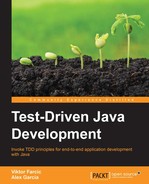In this book, you will find a number of text styles that distinguish between different kinds of information. Here are some examples of these styles and an explanation of their meaning.
Code words in text, database table names, folder names, filenames, file extensions, pathnames, dummy URLs, user input, and Twitter handles are shown as follows: "We can include other contexts through the use of the include directive."
A block of code is set as follows:
public class Friendships {
private final Map<String, List<String>> friendships = new HashMap<>();
public void makeFriends(String person1, String person2) {
addFriend(person1, person2);
addFriend(person2, person1);
}Any command-line input or output is written as follows:
$> vagrant plugin install vagrant-cachier $> git clone thttps://bitbucket.org/vfarcic/tdd-java-ch02-example-vagrant.git
New terms and important words are shown in bold. Words that you see on the screen, for example, in menus or dialog boxes, appear in the text like this: "Once we type our search query, we should find and click the Go button."
..................Content has been hidden....................
You can't read the all page of ebook, please click here login for view all page.
